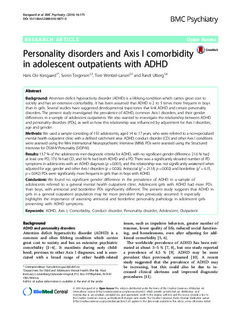| dc.contributor.author | Korsgaard, Hans Ole | |
| dc.contributor.author | Torgersen, Svenn | |
| dc.contributor.author | Wentzel-Larsen, Tore | |
| dc.contributor.author | Ulberg, Randi | |
| dc.date.accessioned | 2016-10-19T12:45:58Z | |
| dc.date.accessioned | 2018-01-17T13:21:38Z | |
| dc.date.available | 2016-10-19T12:45:58Z | |
| dc.date.available | 2018-01-17T13:21:38Z | |
| dc.date.issued | 2016 | |
| dc.identifier.citation | BMC Psychiatry 2016, 16(1) | |
| dc.identifier.issn | 1471-244X | |
| dc.identifier.uri | http://hdl.handle.net/11250/2477980 | |
| dc.description | - | |
| dc.description.abstract | Background
Attention deficit hyperactivity disorder (ADHD) is a lifelong condition which carries great cost to society and has an extensive comorbidity. It has been assumed that ADHD is 2 to 5 times more frequent in boys than in girls. Several studies have suggested developmental trajectories that link ADHD and certain personality disorders. The present study investigated the prevalence of ADHD, common Axis I disorders, and their gender differences in a sample of adolescent outpatients. We also wanted to investigate the relationship between ADHD and personality disorders (PDs), as well as how this relationship was influenced by adjustment for Axis I disorders, age and gender.
Methods
We used a sample consisting of 153 adolescents, aged 14 to 17 years, who were referred to a non-specialized mental health outpatient clinic with a defined catchment area. ADHD, conduct disorder (CD) and other Axis I conditions were assessed using the Mini International Neuropsychiatric Interview (MINI). PDs were assessed using the Structured Interview for DSM-IV Personality (SIDP-IV).
Results
13.7 % of the adolescents met diagnostic criteria for ADHD, with no significant gender difference. 21.6 % had at least one PD, 17.6 % had CD, and 4.6 % had both ADHD and a PD. There was a significantly elevated number of PD symptoms in adolescents with an ADHD diagnosis (p = 0.001), and this relationship was not significantly weakened when adjusted for age, gender and other Axis I disorders (p = 0.026). Antisocial (χ 2 = 21.18, p = 0.002) and borderline (χ 2 = 6.15, p = 0.042) PDs were significantly more frequent in girls than in boys with ADHD.
Conclusions
We found no significant gender difference in the prevalence of ADHD in a sample of adolescents referred to a general mental health outpatient clinic. Adolescent girls with ADHD had more PDs than boys, with antisocial and borderline PDs significantly different. The present study suggests that ADHD in girls in a general outpatient population may be more prevalent than previously assumed. It especially highlights the importance of assessing antisocial and borderline personality pathology in adolescent girls presenting with ADHD symptoms. | |
| dc.language.iso | eng | |
| dc.title | Personality disorders and Axis I comorbidity in adolescent outpatients with ADHD | |
| dc.type | Journal article | |
| dc.date.updated | 2016-10-19T12:45:58Z | |
| dc.subject.nsi | VDP::Medisinske fag: 700::Klinisk medisinske fag: 750::Psykiatri, barnepsykiatri: 757 | |
| dc.subject.nsi | VDP::Midical sciences: 700::Clinical medical sciences: 750::Psychiatry, child psychiatry: 757 | |
| dc.identifier.doi | 10.1186/s12888-016-0871-0 | |
| dc.identifier.cristin | 1359084 | |
| dc.subject.keyword | ADHD / ADHD | |
| dc.subject.keyword | Personlighetsforstyrrelser / Personality Disorders | |
